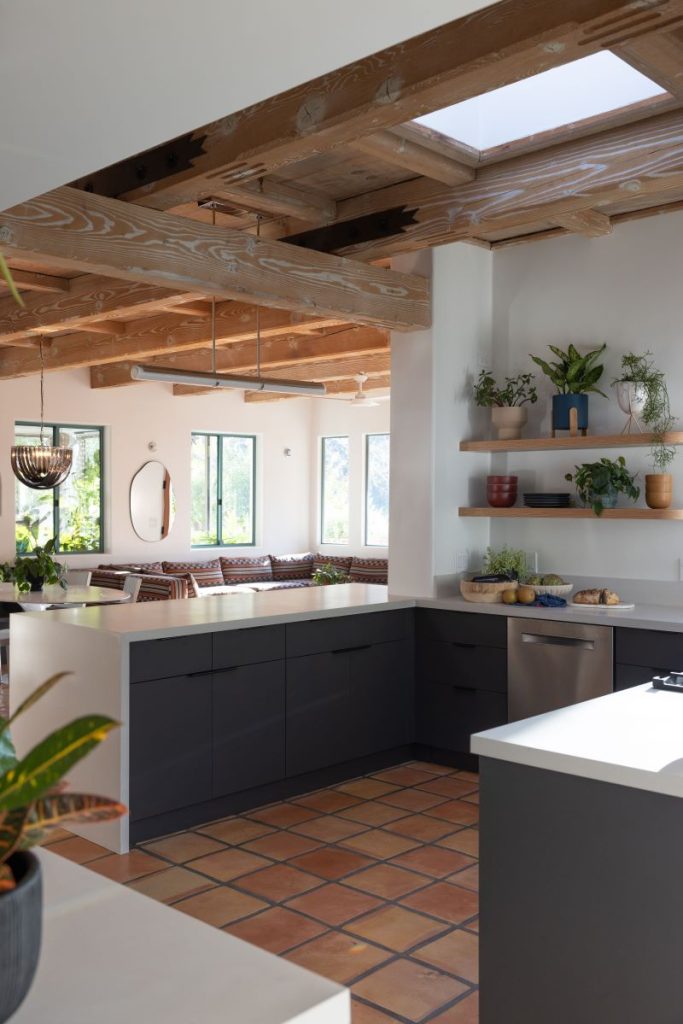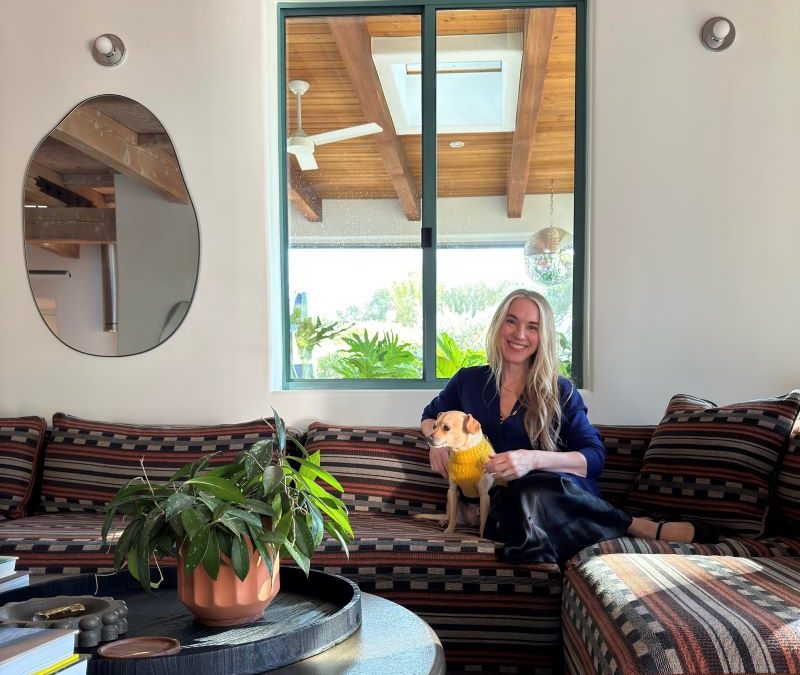
Interior Designer Amy Pigliacampo on Redesigning her Family’s Forever Topanga Home
However large or small our living space, we want it to reflect our style and taste. For most of us with a limited budget, a cushion and a blanket can go a long way to sprucing up a room. But for busy people with a whole house that needs renovating or redesigning and the necessary funds, it’s time to call in a professional.
An interior designer for eight years and a stylist before that, Amy Pigliacampo handles projects from new builds—where she collaborates with architects—to renovations like her family home off Old Topanga Canyon.
Amy and husband Corey Szopinski have two children—Marlowe, 9, and Roman, 8—and a rescue pup called Bruno. They bought the house in March 2023 and the family moved in the following June. The renovation started with an exterior paint job. “It was an intense orange,” said Amy, “with a multitude of 1990s dark colors on the inside.” She chose Sherwin Williams’s “pure white” for the outside of the house.

The most important room in any house, according to Amy, is the kitchen. So that part of the remodel happened before moving in. “When I’m not working, I spend most of my time in the kitchen. And when you have kids, everyone’s eating all the time, so it has to work. If the kitchen is wrong, you’ll notice.”
Amy says she has a subtractive approach to design. “I like to take stuff out, peel back layers, as opposed to adding a lot. That’s how I approach all the houses I design — what’s the least amount of changes we can make to have the most dramatic impact?”
The project was all about working within the constraints of existing materials. The house was quite dated and not Amy’s style, but had been built with largely high quality materials. So she could be strategic about what was kept and what was changed, both from a budget perspective and not wanting to create excess waste. The house has four bathrooms, although only one has been renovated so far.
The trouble with remodels is that no matter how good your builders are, you never know what you might find behind a wall or appliance. “Whoever built our house in the early ’90s didn’t run the flooring to the edges of the walls like you’re supposed to— wall to wall. Then you put in your kitchen,” said Amy. “But they put in the kitchen and tiled around it. That’s a big no-no.”
If Amy had changed the footprint of her kitchen, she would have had to source the original 30-year-old tile. “I didn’t want to do that. It already felt like we were spending a lot of money. The kitchen was awful and had to be done first.”
Regardless of what might lurk behind walls, Amy isn’t scared to knock one down. But she will avoid it if possible. “The less you knock down, the more you’re going to save on your budget.
“I need to know the budget before I can start a project,” said Amy.

If a client says their budget is $100,000, Amy needs to know what they are hoping to change. If they want to change everything on a 2,000-square-foot home in Los Angeles, including re-wiring, the level of upgrade goes up—especially if nothing is to code. “It can cost up to $500,000. And that doesn’t include new furniture. It’s really expensive to remodel a whole house,” said Amy. “That’s why we didn’t gut ours.”
What’s fashionable right now in home decor? “Curves,” said Amy. “Archways. And people are doing finishes on walls again. There’s a resurgence in lime wash. A little bit of wall texture that looks like plaster. That’s a big trend. I like lime wash. I also like white walls.”
Italian Calacatta marble is popular for kitchens, but it’s expensive, gets stained easily, and there are cheaper and hardier alternatives like quartz, says Amy. It can be a safe option to use “agreeable grey” countertops, which Amy says a lot of builders love. “I don’t like it. It’s too basic for me.”
Paint’s a game-changer if you want to unify a house, says Amy. “I never want anything to match, but I like things to look related.” Amy’s house is painted white throughout. “It’s called Pure White, but it’s not pure white. Pure white paint is almost blue. It’s a color I’ve used in quite a few projects. It works if you’re going for something modern. If you are more traditional, there are other options. Whites are hard. You have to try them before you commit. White isn’t for everyone.”
There is no hard and fast rule for colors. “I get concerned when a client wants to pick their paint colors as step one,” said Amy. “Based on what? In the kitchen there might be a lot of white elements, so you should never pick your paint until all those items and appliances are chosen. If a tile is a pure white and you pick a softer, warmer white for the walls, put those two whites together and one could look gray and the other yellow.”
Homeowners should think twice about using a bright color if they are going to move at some point. But Amy says in a place like Los Angeles, if a house has a point of view and style, it will find a buyer. “If someone said they want a dark blue bedroom, I say OK, let’s start with that.”
Amy loves wallpaper as an alternative to paint. “The only reason I don’t use more of it in my own homes is budget. It’s expensive. All the good wallpapers are expensive and wallpaper hangers don’t come cheap. The United Kingdom has the best wallpaper (House of Hackney, Divine Savage, Liberty), so I import it if that’s what a client wants.”
Amy also loves houseplants and always suggests them. But some clients won’t have plants in their home because they can be deadly for some pets, especially cats. So Amy recommends plants that won’t hurt animals.
Typically, an interior designer’s fee is 10 to 15 percent of the remodel or build. “If I’m sourcing the appliances, designing the whole house, we can be spending a year together on a project.”
Amy can source everything for her clients—furniture, plants, pots and appliances. There are lots of questions to be asked before starting a home building project. “If it’s a remodel, the first question is are we changing the floor plan? Are we moving walls? What are all the finishes for the floors, walls and lights? Are we replacing doors and windows? What color handles? A lot of decisions have to be made before you get to furnishings.”
While Amy relies on builders and her husband to do the heavy lifting, she can use tools. “But I don’t like using a drill screwdriver. I don’t like the sound of it. I can put in lighting, but it takes so much longer than you think to do these jobs yourself.”

Amy transformed a 50-foot retaining wall at her Topanga house over four weekends using paint and stencil. “The wall was water damaged, so the painters wouldn’t touch it, and tiling it would have probably cost over $30K in materials and labor, so I came up with the paint-and-stencil solution.”
If you’ve renovated your house before selling, the buyer will be glad someone else has done the work, says Amy. “A lot of buyers don’t want to do any renovations. They find it too overwhelming.”
With all building projects, Amy has this advice. “It’s important to get the right contractor. Get a referral from someone you know who has had a good experience. There’s a lot of bad work out there. You don’t want to be in a position where you have to spend more money to put bad work right. The design part is exciting, but if the client doesn’t have a contractor who can do the job, the design won’t happen. Builders must be bonded and licensed. There will be permits involved and they need to be able to handle that. I would not advise anyone in California, especially in a fire zone like Topanga where there’s a coastal commission, to cut any corners with electricity and permitting.” Amy uses “fairly local” builders, as workers don’t usually like driving a long way to work.
There’s still work to do, but Amy and Corey have already turned their Topanga house into a lovely home that’s stylish, cozy and welcoming. Exactly how a home should be.www.amypigliacampo.com / @amypigliacampo





